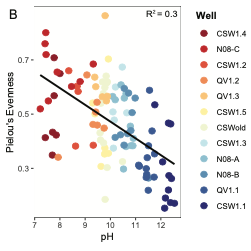Link to online paper: https://journals.asm.org/doi/10.1128/mSystems.00300-21
Abstract
In recent years, our appreciation of the extent of habitable environments in Earth’s subsurface has greatly expanded, as has our understanding of the biodiversity contained within. Most studies have relied on single sampling points, rather than considering the long-term dynamics of subsurface environments and their microbial populations. One such habitat are aquifers associated with the aqueous alteration of ultramafic rocks through a process known as serpentinization. Ecological modeling performed on a multiyear time series of microbiology, hydrology, and geochemistry in an ultrabasic aquifer within the Coast Range Ophiolite reveals that community assembly is governed by undominated assembly (i.e., neither stochastic [random] nor deterministic [selective] processes alone govern assembly). Controls on community assembly were further assessed by characterizing aquifer hydrogeology and microbial community adaptations to the environment. These analyses show that low permeability rocks in the aquifer restrict the transmission of microbial populations between closely situated wells. Alpha and beta diversity measures and metagenomic and metatranscriptomic data from microbial communities indicate that high pH and low dissolved inorganic carbon levels impose strong environmental selection on microbial communities within individual wells. Here, we find that the interaction between strong selection imposed by extreme pH and enhanced ecological drift due to dispersal limitation imposed by slow fluid flow results in the undominated assembly signal observed throughout the site. Strong environmental selection paired with extremely low dispersal in the subsurface results in low diversity microbial communities that are well adapted to extreme pH conditions and subject to enhanced stochasticity introduced by ecological drift over time.
